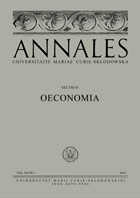Sources of Financial Flexibility and Investment Activity in Family Farms in Poland
Sources of Financial Flexibility and Investment Activity in Family Farms in Poland
Author(s): Joanna BereżnickaSubject(s): National Economy, Agriculture, Socio-Economic Research
Published by: Wydawnictwo Naukowe Uniwersytetu Marii Curie-Sklodowskiej
Keywords: financial flexibility; investment activity; credit; cash; leverage;
Summary/Abstract: Theoretical background: Financial flexibility is a manifestation of the ability to finance investments resulting from the need. The sources of flexibility may be different. These are own money (savings) and financial leverage. The approach to investments is not clear, because they are understood in very different ways and have a diverse nature. Research shows that the higher the financial flexibility, the greater the investment opportunities and the greater the investment activity. Purpose of the article: The aim of the research was to identify investment activity in entities such as family farms, in groups separated according to financial flexibility, and to identify factors that influence the amount of investment expenditure. The idea was to indicate whether this process involves periods of increased activity or is rather a continuous process, how this process takes place in separate groups, and which sources of flexibility are most important for meeting the needs of farmers. Research methods: The research covered approximately 12,000 family farms. Financial flexibility groups were separated based on cash resources and the level of financial leverage. There are 4 groups: HC_HL (highly flexible), HC_LL, LC_HL, LC_LL (lowly flexible). The work uses comparative analysis and panel methods (estimation by weighted averages). Main findings: The research showed that investment activities were carried out with varying intensity at intervals depending on financial flexibility. In groups with greater flexibility, they were more cyclical (there were periods of low activity), in groups with lower flexibility this process was continuous (no periods of a clear reduction in investment expenditure). The main factor that had a positive impact on investment outlays were financial flows from operating activities, but also financial leverage and cash, but only when farmers used credit at the same time. However, the factors that had a negative impact on investment activity were subsidies for investment activities (exception: HC_LL group) and the share of cash in assets. To sum up, it should be stated that credit, as a source of financial flexibility, is the driving force behind investment activities in Polish family farms.
Journal: Annales Universitatis Mariae Curie-Skłodowska, Sectio H Oeconomia
- Issue Year: LVIII/2024
- Issue No: 1
- Page Range: 7-22
- Page Count: 16
- Language: English

